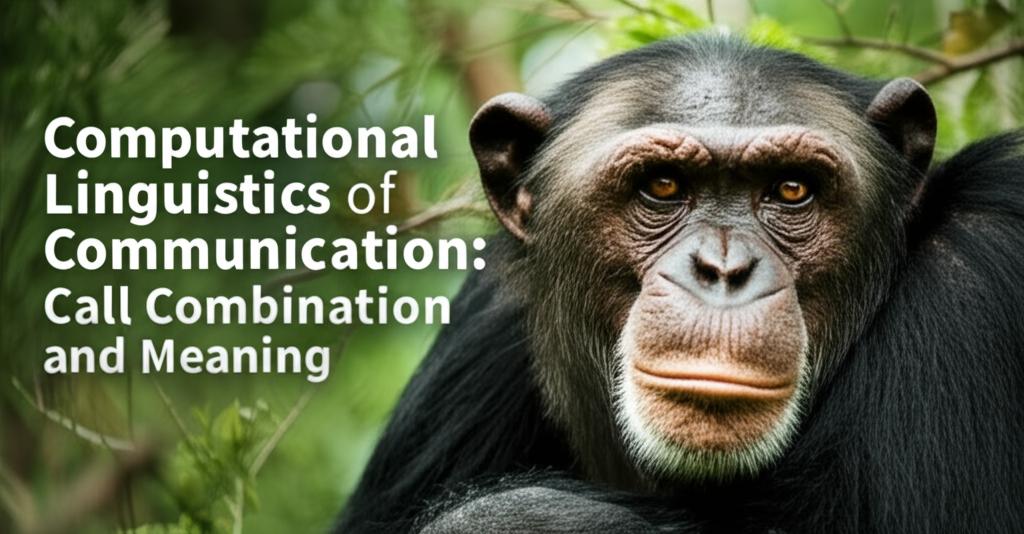Recent breakthroughs in the study of wild chimpanzee vocalizations are reshaping our understanding of the evolution of language. Researchers are employing computational linguistics to delve into the complexities of how chimpanzees combine calls and what these combinations might mean.
Studies, including notable work from the Taï National Park in Côte d'Ivoire, have revealed that chimpanzees possess a surprisingly sophisticated communication system. They don't just rely on single calls; instead, they frequently combine different call types to create a multitude of vocal sequences. This ability to combine calls, sometimes up to ten different types, suggests a system far more complex than previously assumed for non-human primates.
Key Findings in Chimpanzee Call Combinations and Meaning:- Structured Sequences: The order of calls within these sequences isn't random. Researchers have found that calls often appear in predictable positions, following certain rules of adjacency, akin to a rudimentary syntax. This structured nature is a significant finding, as syntax is a core feature of human language.
- Expansion of Meaning: Chimpanzees appear to use call combinations to convey more nuanced or complex messages than single calls alone. They employ several methods to alter meaning through combinations:
Compositional Combinations: In some cases, the meaning of the combined sequence seems to be derived from the meanings of its individual component calls. For example, a call associated with "alarm" combined with a call associated with "recruitment" might together signal a specific response to a threat like a snake. Another instance is merging calls related to feeding and resting to indicate both activities.
Non-Compositional (Idiomatic) Combinations: More surprisingly, chimpanzees also seem to create new meanings with call combinations that are not predictable from the individual calls. An example cited is a combination of calls typically associated with "resting" and "affiliation" being used to signify "nesting." This is similar to idiomatic expressions in human language where the meaning of the phrase isn't a literal sum of its parts.
Order Matters: Evidence also suggests that the order of calls within a sequence can influence its meaning. For instance, a "hoo" followed by a "grunt" might be associated with feeding or resting, while a "grunt" followed by a "hoo" could be used more during travel or when chimp groups merge.
Meaning Modification: Adding a call can modify the meaning of another, somewhat like how prefixes or suffixes work in human language.
- Diverse Contexts: Unlike some animal call combinations that are highly specific to limited situations (e.g., predator encounters), chimpanzees use their call combinations across a wide array of daily life events and social contexts. This versatility suggests a more flexible and general-purpose communication system.
- Communicating Concurrent Events: Research indicates that chimpanzees are more likely to use vocal sequences (combinations) when experiencing multiple events simultaneously or in close succession, suggesting an ability to convey combined information about complex situations.
- Beyond Emotional Expression: These findings point towards chimpanzee communication involving deliberate use of call sequences for complex social information, moving beyond interpretations limited to immediate emotional expressions. This suggests cognitive abilities supporting intentional signaling and contextual flexibility.
These discoveries have profound implications for understanding the evolutionary origins of human language. The presence of structured, meaningful call combinations in chimpanzees – our closest living relatives – suggests that some of the foundational cognitive building blocks for complex communication, possibly even rudimentary syntactic abilities, may have been present in the common ancestor of humans and chimpanzees. This challenges the long-held view that the complex combinatorial abilities of human language emerged entirely anew in the human lineage.
Researchers are now exploring whether chimpanzees organize calls in sentence-like structures and if they embed shorter sequences within longer ones. While chimpanzee communication doesn't possess the full hierarchical complexity and limitless generativity of human language, the observed intricate vocal architecture marks a significant evolutionary step beyond simple associative calling.
Future research, likely involving more playback experiments and detailed contextual analysis aided by computational tools, will continue to unravel the intricacies of chimpanzee communication, shedding further light on the fascinating journey of language evolution. The study of non-vocal communication, such as drumming sequences, also complements these findings, suggesting that semantic compositionality might have ancient roots in primate communication, not necessarily limited to the vocal modality.

